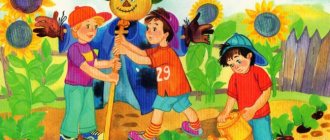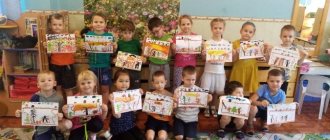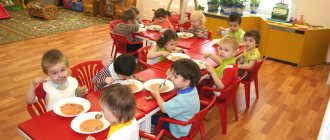The daily routine in kindergarten for all age groups of the kindergarten is based on SanPiN standards, and is designed for a 12-hour stay of a child in a preschool institution. The daily routine in a preschool institution is a strict, down to the minute, sequence of walks, meals, activities, games and daytime rest.
Thanks to such a regimented daily routine in kindergarten, the preschooler develops discipline, a love of order, and the ability to manage his own time, which will facilitate adaptation to school in the future.
In preschool institutions in our country, it is customary to divide children into groups by age. So, the early age group is from 2 to 3 years old; junior group - 3-4 years; middle group - 4-5 years; senior group - 5-6 years; preparatory group 6-7 years old.
However, regardless of the age of the preschooler, the daily routine in kindergarten begins at 7 am, when teachers receive children, and the “working day” in kindergarten begins at 8 am.
Approximate daily routine for a preschooler
7.00-8.30 - Reception of children 8.10 - Exercise 8.30 - Breakfast 9.00-10.00 - Classes 10.30-11.30 - Walk 12.00 - Lunch 12.30-15.00 - Day nap 15.30 - Afternoon snack 16.00-17.00 - Classes 17.00 - Pro party 18:00 - Dinner 19.00 - Care children home
As can be seen from the schedule, according to the recommendations of SanPiN, a kindergarten pupil is provided with four meals a day, with an interval of 4 hours between meals, there are also two walks, one of which is in the afternoon (the time of which may be reduced due to weather conditions), in addition, it is mandatory nap, and of course there is time for activities and games.
It is worth noting that there are slight differences in the daily routine of each group in kindergarten, which take into account the age characteristics of the children.
For example, if the duration of classes in the junior group of a kindergarten is only 10 minutes, then preschoolers of the senior and preparatory groups study for 20-30 minutes, which is close to school classes. The same applies to preparatory moments and getting ready - older children need less time to get dressed for a walk, or wash their hands before lunch.
Next, we will look at several important points from the daily routine in kindergarten in more detail.
Organization of the daily routine of preschoolers
Preschooler's daily routine
The daily routine is of great importance for the health and physical development of children. Constant time for eating, sleeping, walking, playing and studying is what I.P. Pavlov called it an external stereotype - a prerequisite for the proper upbringing of a child.
Daily regime
- this is a clear daily routine of life, providing for the alternation of wakefulness and sleep, as well as the rational organization of various types of activities. A correct regimen that corresponds to the child’s age-related capabilities improves health, ensures efficiency, successful implementation of various activities, and protects against overwork.
The physiological basis that determines the nature and duration of activity is the level of performance of the cells of the cerebral cortex, therefore it is so important not to exceed the performance limit of the central nervous system, as well as to ensure its full functional recovery after work. The degree of morphofunctional maturity of the organism determines the content of the daily routine and the duration of its main elements, among which the following are distinguished:
- dream;
– staying outdoors (walking);
– educational and training activities;
– gaming activities and activities of one’s own choice (reading, music, drawing and other creative activities, sports);
– self-care, family assistance;
– meals;
- personal hygiene.
When carrying out regime processes, the following rules must be adhered to:
1. Complete and timely satisfaction of all organic needs of children (sleep, nutrition).
2. Careful hygienic care, ensuring cleanliness of the body, clothes, bed.
3. Involving children in participating in regime processes as much as possible; encouraging independence and activity.
4. Formation of cultural and hygienic skills.
5. Emotional communication during routine processes.
6. Taking into account the needs of children, the individual characteristics of each child.
7. Calm and friendly tone of address, careful attitude towards the child, elimination of long expectations, since the appetite and sleep of children directly depend on the state of their nervous system.
Basic principles of building a daily routine:
1. The daily routine is carried out throughout the entire period of raising children in a preschool institution, maintaining consistency, constancy and gradualness.
2. Correspondence of the correctness of the daily routine to the age-related psychophysiological characteristics of the preschooler. Therefore, in the National Children's Educational Institution, each age group has its own daily routine.
3. The organization of the daily routine is carried out taking into account the warm and cold periods of the year
WHAT IS THE DAY SCHEDULE IN KINDERGARTEN?
The importance of a child's daily routine
A correct regimen that corresponds to the child’s age-related capabilities improves health, ensures efficiency, successful implementation of various activities, and protects against overwork. In a child accustomed to a strict routine, the need for food, sleep, and rest occurs at certain intervals and is accompanied by rhythmic changes in the activity of all internal organs. The body, as it were, adjusts in advance to the upcoming activity, so it is carried out quite efficiently, without unnecessary waste of nervous energy and does not cause pronounced fatigue. Good performance during the day is ensured by a variety of activities and their alternation. From a physiological point of view, this is explained by the ability of the cerebral cortex to simultaneously work and rest. At each individual moment, not its entire surface is working, but individual areas, namely those that are in charge of this activity (the field of optimal excitability). The remaining areas of the cortex are at rest at this time. All physiological processes in the body, having their own biological rhythm, obey a single daily rhythm - the change of day and night. During the day, the child’s activity and performance are not the same. Their rise is noted from 8 to 12 hours and from 16 to 18 hours, and the period of minimum performance occurs at 14-16 hours. It is no coincidence, therefore, that activities that cause pronounced fatigue in children are planned in the first half of the day, during hours of optimal performance. The duration of periods of wakefulness in preschoolers is limited to 5-6 hours. This implies the need to alternate wakefulness and sleep.
HYGIENIC ASPECTS OF ORGANIZING THE DAY REGIME FOR PRESCHOOL CHILDREN
The concept of “daily routine” includes the duration, organization and distribution during the day of all types of activities, rest and meals. A rationally constructed and organized regime is an important factor in ensuring timely and harmonious physical and mental development of children and adolescents, an optimal level of performance, and also prevents the development of fatigue and increases the overall resistance of the body.
In connection with the beginning of early education and its intensification, deviations are noted in the daily routine of preschoolers, forming functional and other health disorders.
The main hygienic principle of constructing a rational daily routine is its strict implementation, the inadmissibility of frequent changes, and the gradual transition to a new regime of education and training.
According to modern concepts of the theory of functional systems of the body, the development of a dynamic stereotype, as well as its change, occurs gradually, over a certain period of time, under repeated conditions [7]. It is noted that the smaller the child, the more difficult it is to form a dynamic stereotype, and a small child is more sensitive to any changes in it.
The physiological basis that determines the nature and duration of activity is the level of performance of the cells of the cerebral cortex, therefore it is so important not to exceed the performance limit of the central nervous system, as well as to ensure its full functional recovery after work. The degree of morphofunctional maturity of the organism determines the content of the daily routine and the duration of its main elements
Dream
ensures complete functional restoration of all body systems. The physiological need for sleep in children of different ages depends on the characteristics of their nervous system and state of health (Table 1). In the preschool period, both night and daytime sleep are required, regardless of whether the child attends a preschool educational institution (DOU), a short-stay group or not. A full night's sleep is important for both preschoolers and schoolchildren, since it is known that it is during this period that information is transferred from short-term (operative) memory to long-term memory, which is a necessary condition for educational activities and mental development. Depending on age, bedtime is recommended to range from 20:30 to 22:30 hours.
Table 1. Duration of sleep in children
Staying in the open air
(walking) is the most effective type of rest, due to increased blood oxygenation, replenishment of ultraviolet deficiency, allowing for hardening of the body and an increase in physical activity. Walks are especially important for preschool children: in winter, at least 4-4.5 hours, and in summer, if possible, all day. The walk is not carried out at an air temperature below -15 °C and a wind speed of more than 15 m/s for children under 4 years old, and for children 5-7 years old at an air temperature below -20 °C with a wind speed of more than 15 m/s (for average stripes).
Educational activities.
When building a rational training regimen, one should take into account the biorhythms of the functioning of the child’s body. In most healthy children, the greatest excitability of the cerebral cortex and performance are determined in the morning - from 8:00 to 12:00 hours and in the evening - from 16:00 to 18:00 hours.
Training and education programs at preschool educational institutions provide for developmental activities. In the younger group, the duration of classes is 10-15 minutes (10 lessons per week), in the middle group (4-5 years old) - 20 minutes (10 lessons per week), in the older group (5-6 years old) - two lessons per week. day for 20-25 minutes with a break of 10 minutes. In the preparatory group (6-7 years old) - 3 lessons a day are held for 25-30 minutes, taking on the nature of training. The duration and frequency of classes during the day and week for children who do not attend preschool educational institutions should correspond to the recommended ones, as for children of organized groups. Hygienic studies have shown that classes on speech development, literacy, mathematics, and familiarization with the outside world are more tiring than modeling, drawing, and design. Physical education and music (dynamic exercises) reduce or relieve fatigue.
Currently, there is a large selection of additional educational services for preschoolers. Hygienists recommend conducting additional education classes for children of the 4th year of life no more than once a week, lasting no more than 15 minutes; for children 5-6 years of age - no more than 2 times a week and no more than 25 minutes; for children 7 years of age - no more than 3 times a week, lasting no more than 30 minutes. It is unacceptable to conduct these activities at the expense of walking and sleeping time.
Gaming activities and recreation of your own choice
contribute to the formation of positive emotions in children, individual inclinations and the development of creative abilities. It is imperative to give the child time for free activities of his own choice (reading literature, playing music, drawing, sports, social work).
Play activities for preschoolers are allotted time in the morning before breakfast, during walks in the first and second halves of the day, after naps and in the evening before bed. Games should be varied, individual and group, role-playing, didactic, and active. Thus, didactic games are similar to educational activities, are characterized by low mobility, and provide an emotional coloring of wakefulness. Outdoor games, especially outdoors, help strengthen the body, increase its endurance, and improve movements. Every day, children can spend their free time in accordance with their interests and do what they love. Such a vacation brings pleasure, evokes positive emotions, and relieves psychological stress. It must be remembered that watching TV and working on the computer create conditions for a significant load on the visual analyzer.
Time for self-care, helping family
should also stand out in the daily routine. Preschool children can perform simple self-care duties, helping to clean dishes and rooms (no more than 15 minutes a day). Both at home and at school, students can and should provide all possible assistance in cleaning the premises, putting away dishes, watering plants, caring for younger children, etc. Learning self-service and engaging in socially useful work must begin from the first years of school. It is strictly forbidden to involve children in work that poses a risk to life, is unsafe from an epidemiological point of view (cleaning toilets) and exceeds the physical capabilities of the child’s body. The duration of such work for preschoolers should be no more than 30 minutes.
Meals and personal hygiene
are mandatory components of the regimen for children of any age. The concept of diet includes strict adherence to the timing of meals and the intervals between them, a physiologically rational frequency of meals, the correct distribution of the quantity and quality of food among meals. If the intervals between meals are not observed, normal gastric secretion is disrupted and appetite decreases. Preschoolers without health problems should eat 4-5 times a day with an interval of 3.5-4 hours
Compliance with a rational daily routine by children and adolescents helps to strengthen and improve their health, as well as increase the effectiveness of educational and educational activities.
Recommendations for parents “Organization of the daily routine in the conditions of family education”
In modern conditions, many parents believe that they can give their child much more knowledge at home. In this regard, they take on great responsibility. When raising a child at home, you need to understand that the child is deprived of full communication with peers at various regime moments. Communication only on the street is not enough. The child must learn to interact with other children in classes and matinees. Nowadays, kindergartens pay great attention to the diversified development of the child. Here are a few simple rules for organizing a daily routine in a family environment:
1. Follow the daily routine and diet adopted in kindergarten at home.
2. At home, praise the child for showing independence, performing proper hygiene procedures, fostering the habit of cleanliness (washing, washing feet before bed in the summer, monitoring the condition of hands, washing hands after a walk, using toilet paper, brushing teeth, rinsing mouth after food).
3. Maintain a walking routine. Give your child the opportunity to move freely during walks. Start a family tradition of playing sports.
4. Provide an emotional, joyful background to the child’s life. Maintain a joyful atmosphere in the family. Keep the traditions of family holidays. Visit theaters with your child. Concerts. Circus.
5. To eliminate and prevent violations in sound pronunciation, conduct play exercises with your child. Special game exercises are also used to develop phonemic hearing and speech attention.
6. Let children at home, under the supervision of an adult, cut with scissors, sew with a needle, sculpt, and so on.
7. Tell and show your children a lot, read fiction.
Compliance with these rules by parents will make life easier for their children. After all, the situation may change and the child will need to go to kindergarten. In this case, he will already have basic self-service skills.
Kindergarten classes
As mentioned above, the duration of classes depends on the age of the child. A lesson in the junior group lasts 10 minutes, 15 minutes in the middle group, 20-30 minutes in the senior and preparatory groups.
In these classes, the preschooler learns a lot of new things, begins to form his horizons, and becomes familiar with the basics of writing and mathematics. If the kindergarten is specialized, with a certain focus, then additional classes may be included in the schedule. Also, the schedule in the middle and senior groups may include additional thematic classes and developmental clubs.
In kindergarten, not only the time of classes is regulated, but also their distribution throughout the day. The schedule is drawn up so that children not only do not become overtired, but also make the most of their activity.
Thus, classes that require increased concentration are carried out in the first half of the day, between 9 and 12 hours, all others - in the afternoon, between 16 and 18 hours. Activities that require perseverance and attention alternate with outdoor games and gymnastic warm-ups.
In addition, the most complex subjects, such as the basics of mathematics and writing, and speech development, are scheduled in the first days of the week, when preschoolers are most alert; for the rest (music classes, drawing, etc.) the second half of the week is usually reserved.
Meals
The main meals in kindergarten are breakfast, lunch, afternoon snack and dinner, if the child is in kindergarten until 19:00.
In all preschool institutions, regardless of their focus, meals are scheduled at approximately the same time: at 8.00-8. 30 breakfast, 12.00-13.00 lunch, 15.00-15.30 afternoon tea, 18.00 dinner.
In the daily routine according to SanPiN, each meal is preceded by preparation: children wash their hands and sit down at tables. The time for this preparation is also regulated and reduced depending on the age group.
Benefits of kindergarten education
Benefits of kindergarten education
Not all children attend preschool institutions - some have mothers who do not work, others have grandmothers. Most kids have to go to kindergarten, spending almost the whole day there. This necessity is not a disadvantage of parenting. On the contrary, it teaches children the perception of an organized team, whose life is subject to a certain routine.
Advantages of regime education
- The daily routine creates conditions for independence skills. Toddlers learn to dress, clean up after themselves, follow hygiene rules, and take care of their natural needs faster than children at home.
- In a preschool institution, a certain time is allocated not only for eating and sleeping, but also for group games, thereby promoting the development of the ability to share toys, help each other, relieving children of egocentrism.
- Much attention is paid to classes. Their content depends on the age group, but each lesson is selected taking into account the mental development of children. During classes, children learn logical thinking, oral speech, and demonstrate their musical and artistic abilities.
- The daily routine also includes hours for physical exercise and walks in the fresh air, which allows children to grow up healthier. Mobility makes it possible to usefully spend accumulated energy. This promotes good appetite and sleep.
By obeying the routine in kindergarten, children become more organized in the family. At the same time, they learn to moderate their personal desires and more often take into account the needs of people close to them.
Walks and quiet time
These important components of the daycare routine are also age-appropriate.
Children from the early age group go for a walk earlier than others, at 9.00-9.30. The quiet hour has also been increased - babies sleep on average from 12.30 to 15.00.
Children from the senior group and the preparatory group go to a quiet hour at 13.00; their sleep lasts an average of 1.5 hours. They also have a shorter time to prepare for a walk - children at this age can already independently and quickly change clothes for playing in the fresh air.
However, regardless of age, quiet time in kindergartens ends at 15.00. After afternoon tea, the younger groups have a general education lesson; students from the middle and older groups are engaged in games or independent activities.
During the second walk, the children are gradually picked up by their parents. In winter, due to the fact that it gets dark quite early, the time for the second walk is reduced, and children are taken directly from kindergarten. Also, the walk may be shortened due to weather conditions: for example, frost or strong wind.
Age specific features
Age characteristics
The daily routine in kindergarten described above is the basis for all groups. Modifications are present only in moments dedicated to classes. Thus, educational activities, which are allotted hours between breakfast and a walk, include speech development and teaching mathematical skills, physical education and music (choreography), artistic activities (drawing, modeling).
Features of the daily routine in the younger group
The goal of primary care teachers is to teach each child independence. Toddlers must be able to dress and undress, wash, brush their teeth, eat, and clean up toys without assistance. Therefore, in the daily routine they pay attention to the following points:
- training in cultural and hygienic skills;
- getting used to a routine - developmental activities, sleep, food, walks only during the designated hours;
- free games that allow you to get used to interacting with other children.
Having learned to obey the regime, older children will more easily accept the stress that awaits them in the older age group.
Daily routine in kindergarten, senior group
Features of the daily routine in the senior group
Having transferred children to the older group, their education is taken more seriously, raising the level of difficulty of classes and increasing their duration. Now the teacher’s goal is to develop creative and mental abilities. To achieve this, sleep and walking time for preschoolers is reduced.
- In the first half of the day, educational games are aimed at mental stress, but such classes are held 1-2 times a week. Lighter lessons are held in the evening hours, interspersed with physical or musical classes.
- Games - theatrical, role-playing, and didactic - allow children to develop communication skills.
- The children are gradually starting to prepare for school. But the purpose of these classes is not to teach children to read and write well, but only to lay the foundations for mastering such knowledge. Here, classes are introduced to develop speech and expand vocabulary, and improve fine motor skills.
The organization of the daily routine takes into account not only the age of the children attending the institution, but also the time of year. Thus, the summer period is more suitable for improving health, so at this time more hours are allocated for walking and playing in the fresh air. The cold season is more filled with educational activities.
Games, joint and independent activities
Games and shared activities are very important for children. They teach children to communicate, develop creative thinking and imagination. During joint classes, a group of children completes tasks proposed by the teacher, thus preschoolers learn to work in a team and develop communication skills.
A total of three hours are allotted for independent games and activities, which allows the child to devote time to his own interests. Children play during the remaining time in such a tight schedule: before morning exercises, before and after classes, during walks.
- share with your friends!







